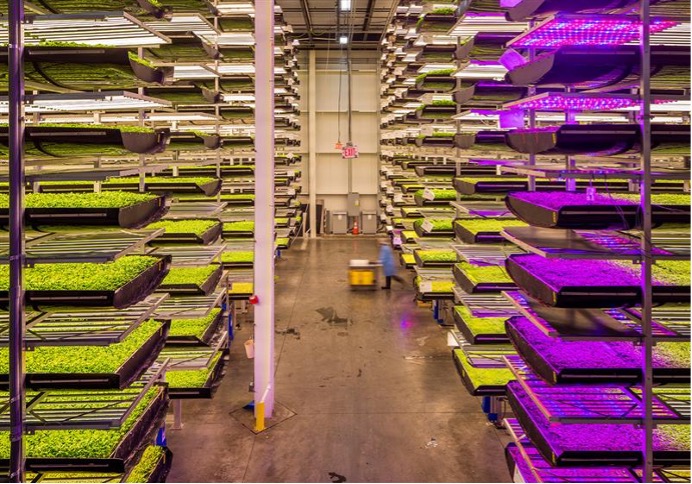Insight Focus
- Singapore produces 10% of its food but has just 1% farmland.
- Strategy includes import diversification.
- Urban farming, farmland abroad also key elements.
Food security is an increasingly important issue around the world. Populations are expanding and climate change is making food production more challenging. Singapore’s innovations on food security offer an insight to other countries aiming to boost it.
Singapore’s Fight for Food Security
Singapore is the world’s second most densely populated nation (after Monaco). However, it’s heralded as one of the most food secure nations, even though its population is growing rapidly its farmland is shrinking.
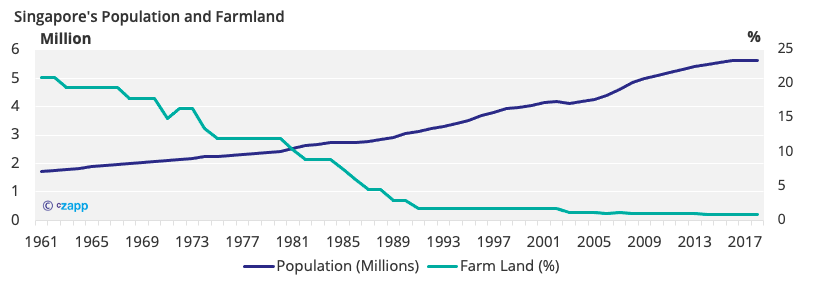
Singapore produces 10% of its food but has just 1% farmland. By comparison, neighbouring Malaysia can produce 145% of its food with 25% farmland. Singapore is therefore heavily reliant on imports, which isn’t ideal with logistical costs and food demand both increasing.
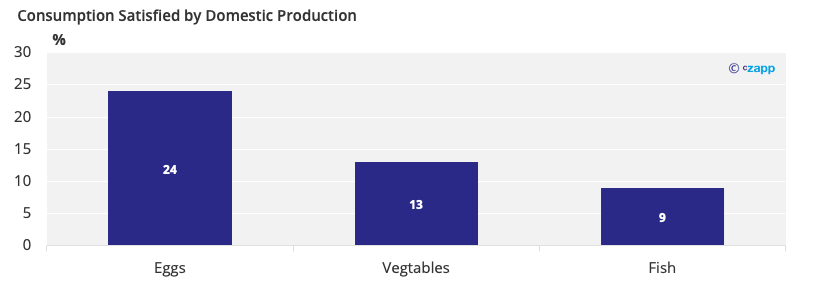
The government has ensured food supply using several methods:
Structured Import Programmes
In the 1990s, all of Singapore’s rice came from Thailand, but today, a legislation decrees that food staples must be imported from a variety of origins.
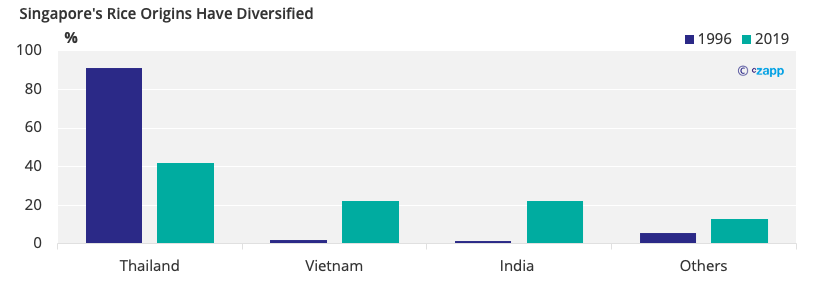
This ensures importers aren’t reliant on individual countries and are ultimately less exposed to regionalised supply issues.
By law, importers of rice and other food staples must also have at least two months of supply stockpiled at all times so reserves and prices don’t fluctuate frantically in times of crisis.

Overseas Agricultural Expansion
Singapore encourages domestic food companies to buy land overseas to cultivate food there, which can be shipped home.
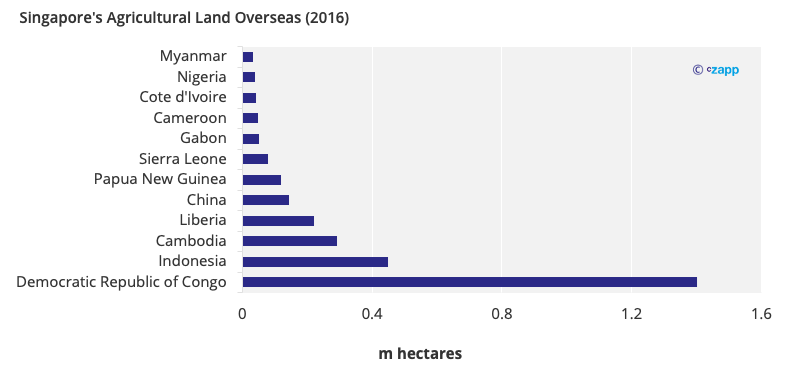
This strategy is not unique to Singapore. South Korea, the UAE, and China have all bought foreign agricultural land, at least, in part, to satisfy domestic demand.
Buying up land overseas is not without controversy, though. The United Nations has called it ‘neo-colonialism’, so, increased activity here could lead to trouble down the line, especially if Singapore starts removing food from countries that are facing famine or similar issues of their own.
Urban Farming
Between 2015 and 2020, Singapore’s government invested USD 28 million to help raise domestic food production. A large amount of this investment went towards urban farming.
There has long been a tradition of urban farming dating back to ancient Persia, but here’s what we’re seeing in Singapore:
Vertical Farming
Vertical farms have several layers of plants, so effectively have eight times the area of a conventional farm with the same footprint.

Although vertical farming only works for a small number of crops, its highly controlled environment is favoured because nutrients, water, humidity, pests, light, and temperature can all be kept at the optimal level for yield development.
Natural disasters, seasonal conditions, and diseases are also less likely to impact crop development, so yields are not only high, but consistent.
In the very best circumstances, yields are higher than they are on conventional farms. Lettuce yields, especially, are almost 14 times higher than they are in a conventional setting. The need for pesticides and fertilisers is also reduced, so it gets marks for sustainability, too.
Vertical farming does have its criticisms, though, with many wondering whether it is an efficient use of space when so many in cities are still seeking housing. Vertical farms are also extremely energy and cost inefficient.
Aquaponics
This method enables two important agricultural products to be produced simultaneously, maximising space. With aquaponics, both fish and vegetable farming occur in the same environment, with the fish urine and unused food fertilising the plants.
There are several aquaponic farms in Singapore, one as large as 7000 ft2. Some of the country’s restaurants and hotels grow food via this method as well. The Stamford, for instance, has a rooftop aquaponic farm that produces 1,200 kg and 350 kg of vegetables and fish respectively each month. Using this method, the hotel supplies 30% of its vegetables and 10% of its fish.
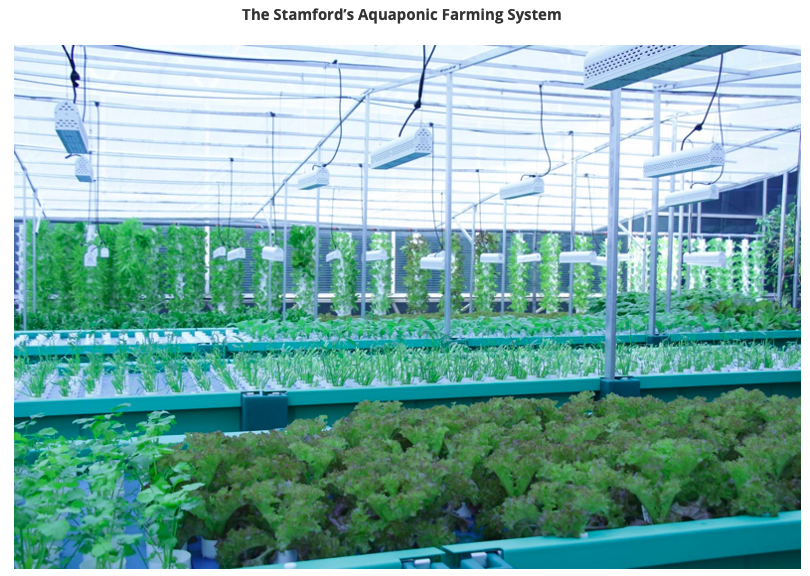
Other More Traditional Methods
Some rooftops have been converted into small farms, utilising what would otherwise be largely unused space.

And urban farming has also extended to Singapore’s waterways, where fish farms have been created to help boost the country’s fish self-sufficiency (currently at 9%).

Alternative Protein Exploration
Meat farming is near non-existent in Singapore, given its limited agricultural space.

It’s therefore become a world leader in the alternative protein market, being the first nation where it was legal to sell lab-grown meat.
Plant-based, insect-based, and cultured meats are all proving popular in Singapore. Deliveroo reported a 60% increase in plant-based food orders in 2020.
Singapore’s investment in its protein market, coupled with the fact it’s pushing foreign companies to invest and produce food in the country, should also mean this market continues to grow.
Although the government is not aiming for every consumer to move towards alternative proteins, their adoption will reduce the country’s reliance traditional meat, standing it in better stead for any potential crisis.
And whilst these proteins aren’t yet cost effective or scalable, they may be an efficient way for Singapore to provide ‘meat’ to its population in the future.
Minimising Food Waste
Finally, Singapore has launched a policy to combat food waste, both at the consumer level and long before that (as we’ve seen in the EU).
To combat consumer waste, the government is asking consumers to resist excessive ordering when eating at restaurants. It’s also pushing them to write shopping lists, so they don’t buy food that’s already in their cupboards at home.
And for businesses, the government is sharing guidance that’ll help them manage internal waste. For instance, companies are being instructed to serve correctly sized portions, offering a wider range of portion options as well.
Concluding Thoughts
- Singapore is a pioneer when it comes to food security.
- Its population has grown by almost 350% since the 1960s, whilst its farmland has almost vanished.
- The government has combatted this dynamic by diversifying imports and stockpiling staple foods.
- It’s also explored overseas agricultural expansion, as we’ve seen in China and other parts of the world.
- Locally, it’s expanded its urban farming repertoire and continued to invest in alternative proteins.
- And whilst it’s pushed to get more food into the country, it’s ensured that it cherishes what it has, combatting food waste all along the supply chain.
- Whilst some of these methods have been around for a while, nations around the world can learn lessons from Singapore’s relentless effort to ensure food security.
Other Insights That May Be of Interest…
Is the EU Focussing on the Right Area of Food Waste?
